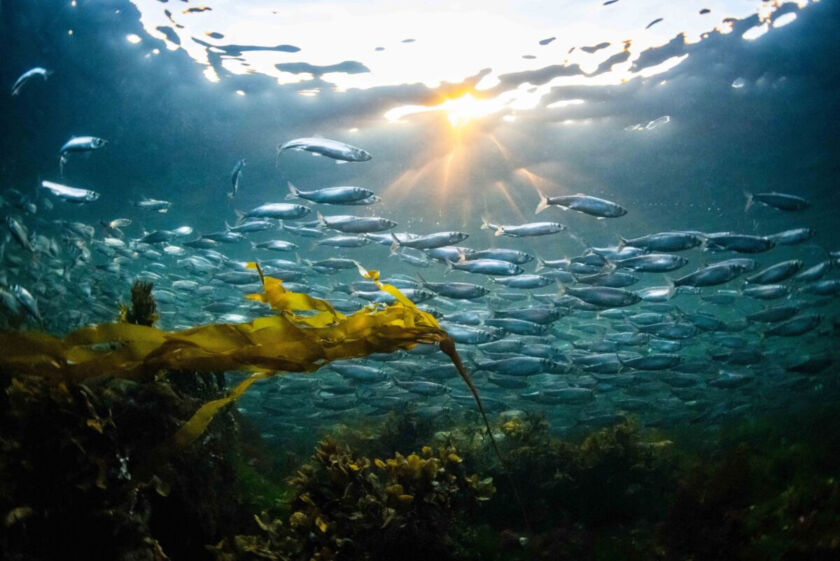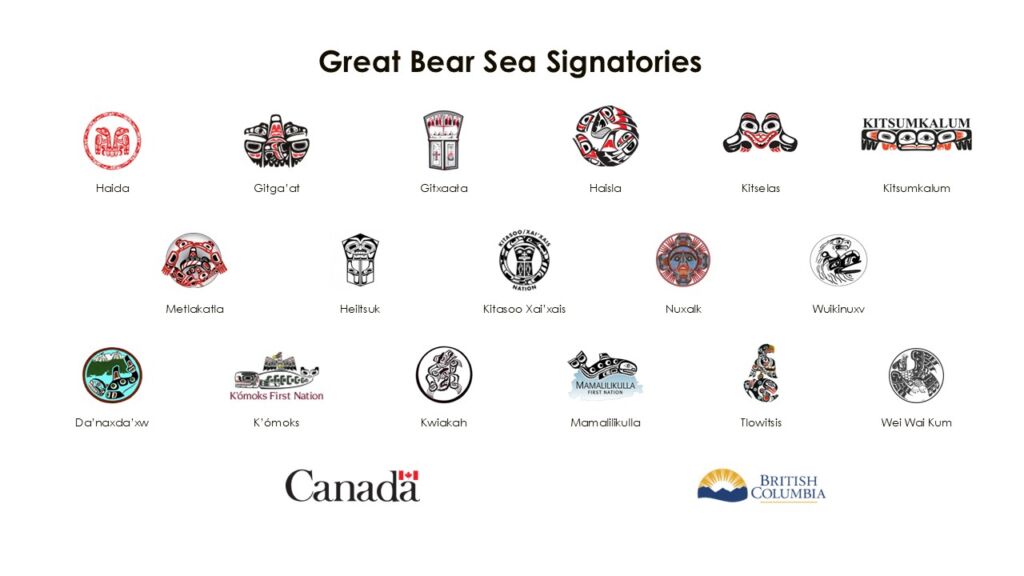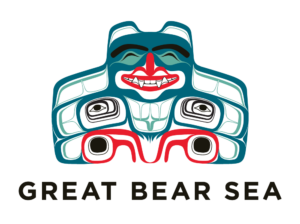Great Bear Sea
The Great Bear Sea encompasses over 10 million hectares of marine and coastal ecosystems off the coast of British Columbia. These waters are some of the richest, most productive cold-water ecosystems in the world and have sustained coastal peoples for tens of thousands of years.

For tens of thousands of years, Indigenous peoples have used their knowledge of coastal ecosystems to build thriving communities and strong cultures, link Nations together through trade and family ties, and sustain the abundance of ocean and coastal ecosystems.
In recent years, overfishing, increased shipping traffic, and climate change are impacting the Great Bear Sea, harming the coastal peoples and wildlife that depend on a healthy ocean.
To protect these life-giving seas, First Nations have partnered with the governments of Canada and British Columbia to design a network of marine-protected areas and secure long-term funding, through the Great Bear Sea project finance for permanence (PFP) initiative, to fund stewardship and sustainable economic development in coastal communities.
Great Bear Sea PFP
The Great Bear Sea PFP, announced in June 2024, secures $335 million in long-term funding to support 17 First Nations in continuing to exercise their stewardship responsibilities, invest in their communities, and work collaboratively with one another and with Crown governments to manage their marine territories.
What is a PFP?
Project finance for permanence is a model of structuring large-scale conservation investments to support lasting protection of ecosystems alongside human well-being. The model:
- Integrates multiple revenue sources,
- Holds parties accountable by a single “closing,” and
- Secures ecological, financial, policy, admin measures all at once.
Established in 2007, the Great Bear Rainforest PFP delivered through Coast Funds was the first of its kind, inspiring conservation organizations all over the world to implement this innovative financing model.
Since its inception, First Nations used the Great Bear Rainforest PFP financing to protect 7 million hectares of land and marine territory, establish 18 Guardian programs, support over 1,400 permanent jobs, create and acquire 140 businesses, revitalize languages and culture, and attract $444 million in investments to the coast. This successful model paved the way for the Great Bear Sea PFP.
Great Bear Sea PFP Structure
The Great Bear Sea PFP is supported by contributions from the Government of Canada ($200M), Province of British Columbia ($60M), and philanthropic partners ($75M). Together, we have developed funding steams that enable us to care for our marine territories and support sustainable economic development on the coast.
- Marine Stewardship Fund ($167M), delivering ongoing funding (through an endowment) for First Nations’ marine stewardship work, including conservation projects, Guardian programs, and MPA implementation, monitoring, and governance.
- Community Prosperity Fund ($120M), delivering funding (over 20 years) for First Nations’ investments in coastal communities, including sustainable business, regional economic development, community infrastructure, education and training, and other community priorities.
- MaPP Implementation Fund ($48M), delivering funding (over 20 years) to support regional marine planning and collaboration through the Marine Plan Partnership (MaPP) for the North Pacific Coast.


Marine Protected Areas Network
First Nations and Crown governments co-developed an action plan for a network of marine protected areas (MPAs) in the Great Bear Sea.
The Great Bear Sea, also known as the Northern Shelf Bioregion , encompasses 10.2 million hectares of marine area covering two-thirds of the coast of modern-day British Columbia. The MPA Network includes 2.8 million hectares of new and enhanced marine protected areas in the Great Bear Sea.
Protecting Ecosystems and Cultural Sites
By linking these protected areas and managing them as a group, First Nations and their partners will protect critical habitats, culturally important sites, and sensitive ecosystems, bringing Canada closer to its commitment to conserve 30% of its lands and waters by 2030.
Learn more: mpanetwork.ca
A Historic Achievement for Indigenous-led Conservation
Signatories
For decades, First Nations have led in the development of protected areas in the Great Bear Rainforest, leading to the creation of Coast Funds. for the Great Bear Sea PFP builds on this foundation, supporting 17 First Nations to extend protections and conservation financing from the rainforest to the sea.
First Nations selected Coast Funds, which managed Great Bear Rainforest funding, to administer the Great Bear Sea PFP funding. We are grateful to continue serving First Nations and to champion Indigenous-led conservation and stewardship.
Learn more about funding partners: ourgreatbearsea.ca/partners/

Resources and Media Releases
Great Bear Sea PFP Booklet
Na̲nwak̲olas Council; Coastal First Nations; Coast Funds. June 25, 2024
Great Bear Sea PFP Agreements
Media Releases
First Nations of the North Pacific coast celebrate milestone for coastal conservation and community development
Na̲nwak̲olas Council; Coastal First Nations; Coast Funds. June 25, 2024
- Media Release: English
Protecting more of our marine ecosystems together, for future generations
Prime Minister Justin Trudeau. June 25, 2024
Backgrounder: Great Bear Sea Project Finance for Permanence
Fisheries and Oceans Canada. June 25, 2024
Coastal First Nations, Na̲nwak̲olas Council, and Coast Funds welcome BC’s $60M investment in the Great Bear Sea
Na̲nwak̲olas Council; Coastal First Nations; Coast Funds. December 5, 2023
- Media Release: English
B.C. supports collaborative marine conservation, economic development on North Coast
Province of British Columbia. December 5, 2023
- Media Release: English
Marine Protected Area Network partners endorse plan to protect British Columbia’s North Coast
Na̲nwak̲olas Council; Coastal First Nations; Fisheries and Oceans Canada; Environment and Climate Change Canada; Ministry of Land, Water, and Resource Stewardship (BC). February 5, 2023
First marine refuge within the Northern Shelf Bioregion is established
Mamalilikulla First Nation; Fisheries and Oceans Canada; Ministry of Land, Water, and Resource Stewardship (BC). February 5, 2023
Federal government commits to developing conservation finance model for Great Bear Sea
Na̲nwak̲olas Council; Coastal First Nations. December 7, 2022
- Media Release: English
Protecting more nature in partnership with Indigenous Peoples
Prime Minister Justin Trudeau. December 7, 2022
Further Reading
- Explore the Great Bear Sea
- MPA Network Action Plan
- About Marine Protected Areas

